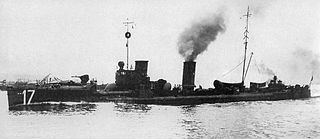
SMS S36 was a 1913 Type Large Torpedo Boat of the Imperial German Navy during World War I, and the 12th ship of her class. She was equipped with of three single mounted 8.8 cm SK L/45 naval guns and with six 50 cm (19.7 in) torpedo tubes, two forward and four aft; twenty-four mines could also be carried. She was launched on 17 October 1914 and commissioned on 4 January 1915. S36 took part in the Battle of the Gulf of Riga in 1915 and the Battle of Jutland in 1916. In late 1916 she served in the English Channel and took part in a number of engagements, including the Battle of Dover Strait during which a British merchant ship and a destroyer were sunk by her Half-Flotilla. She was scuttled at Scapa Flow in 1919.
SMS S50 was a V25-class torpedo boat of the Imperial German Navy. Launched in 1915, she served through the rest of the war, taking part in the Battle of Jutland and operations in the Baltic. She was scuttled at Scapa Flow in 1919, but was later raised and scrapped.

SMS S35 was a 1913 Type Large Torpedo Boat of the Imperial German Navy during World War I. She served at the Battle of Jutland where she was sunk by British battleships.

SMS V186 was a S-138-class large torpedo boat of the Imperial German Navy. She was built by the AG Vulcan shipyard at Stettin between 1910 and 1911 and launched on 8 February 1911.

SMS V191 was a S-138-class large torpedo boat of the Imperial German Navy. She was built by the AG Vulcan shipyard at Stettin between 1910 and 1911 and launched on 2 June 1911.

SMS S33 was a V25-class large torpedo boat of the Imperial German Navy that served during the First World War. She was built by the Schichau-Werke shipyard in Elbing, East Prussia, being launched on 4 April 1914 and was completed in October that year.
SMS S34 was a V25-class large torpedo boat of the Imperial German Navy that served during the First World War. She was built by the Schichau-Werke shipyard in Elbing, East Prussia in 1913–1914 and was completed in being launched on 4 April 1914 and was completed in November 1914.
SMS V29 was a V25-class torpedo boat of the Imperial German Navy that served during the First World War. The ship was built by AG Vulcan at Stettin in Prussia, and was completed in September 1914. The ship took part in the Battle of Dogger Bank and the Battle of the Gulf of Riga in 1915, and was sunk at the Battle of Jutland on 31 May 1916.
SMS G197 was a S-138-class large torpedo boat of the Imperial German Navy. She was built by the Germaniawerft shipyard at Kiel between 1910 and 1911, and was launched on 23 June 1911, entering service later that year.
SMS V26 was a V25-class torpedo boat of the Imperial German Navy that served during the First World War. The ship was built by AG Vulcan at Stettin in Prussia, and was completed in June 1914.
SMS V28 was a V25-class torpedo boat of the Imperial German Navy that served during the First World War. The ship was built by AG Vulcan at Stettin in Prussia, and was completed in September 1914. The ship took part in the Battle of Dogger Bank, the Battle of the Gulf of Riga in 1915, and the Battle of Jutland on 31 May 1916.
SMS V30 was a V25-class torpedo boat of the Imperial German Navy that served during the First World War. The ship was built by AG Vulcan at Stettin in Prussia, and was completed in November 1914.
SMS S15 was a V1-class torpedo boat of the Imperial German Navy. The ship was built by Schichau-Werke, at their Elbing shipyard, completing in 1912.
SMS S16 was a V1-class torpedo boat of the Imperial German Navy. The ship was built by Schichau-Werke, at their Elbing shipyard, completing in 1912. S16 served with the German High Seas Fleet during the First World War, taking part in the Battle of Jutland in 1916. She was sunk by a mine on 20 January 1918.

SMS S17 was a V1-class torpedo boat of the Imperial German Navy. The ship was built by Schichau-Werke, at their Elbing shipyard, completing in 1912. S17 served with the German High Seas Fleet during the First World War, taking part in the Battle of Jutland in 1916. She was sunk by a mine on 16 May 1917.

SMS S19 was a V1-class torpedo boat of the Imperial German Navy. The ship was built by Schichau-Werke, at their Elbing shipyard, completing in 1913. S19 served with the German High Seas Fleet during the First World War, taking part in the Battle of Jutland in 1916. The ship survived the war, serving in the Weimar Republic's Reichsmarine. She was scrapped in 1935.

SMS S23 was a V1-class torpedo boat of the Imperial German Navy. The ship was built by Schichau-Werke, at their Elbing shipyard, completing in 1913.
SMS G193 was a S-138-class large torpedo boat of the Imperial German Navy. She was built by the Germaniawerft shipyard at Kiel between 1910 and 1911, and was launched on 10 December 1910, entering service in 1911.
SMS S49 was a V25-class torpedo boat of the Imperial German Navy. S49 was built by Schichau-Werke, at their Elbing shipyard. She was launched on 10 April 1915 and completed in July that year.
SMS S51 was a V25-class torpedo boat of the Imperial German Navy. Ordered immediately after the outbreak of the First World War, S51 was built by Schichau-Werke, at their Elbing shipyard. She was launched on 29 April 1915 and completed in September that year.






